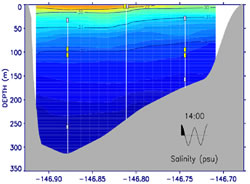Researchers believe that water exchange between the Gulf of Alaska and Prince William Sound is the main physical process influencing the abundance and distribution of microscopic plants and animals, called plankton, that form the base of the marine food web.
Moored instruments are anchored to the ocean floor. This prevents the instruments from drifting in currents, and enables them to take measurements repeatedly at the same location. Moorings are often equipped to measure temperature, salinity, and current velocity.
AOOS employs ocean moorings as well as nearshore moorings.
Water Properties and Exchange
To help us learn about water exchange, we deployed moored Acoustic Doppler Current Profilers (ADCPs) in the two main entrances of the Sound — Hinchinbrook Entrance and Montague Strait — to obtain measurements that allow volume estimates of water transport.
Conductivity, Temperature, and Depth
Each mooring has a conductivity-temperature recorder (CTD) mounted at three different depths. CTDs sample temperature and salinity, and thus track changes in water properties over time.
CTDs help identify periods of deepwater (colder and saltier) exchange between the Sound and the Gulf of Alaska. The data also help to determine the amount of freshwater coming into the Sound from the Copper River Delta, or from any of the many glaciers around the Sound.


